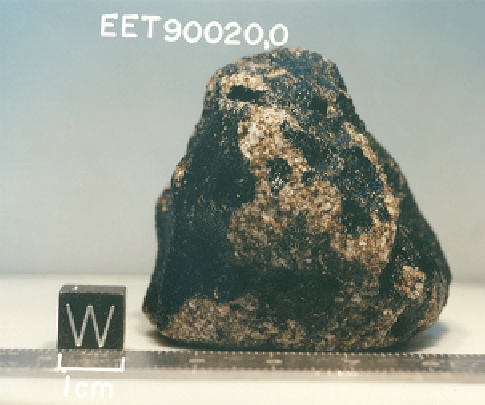Geology Reference
In-Depth Information
Eucrite
154.02 g
Found January 4, 1991
5.3 × 4.5 × 4.8 cm
Weathering = A
crust of their parent body (likely 4 Vesta) and thus have a recrystallized
texture that formed during this more intense heating. in addition, the
crust experienced intense heating from impact events onto the surface.
Distinguishing between these two different kinds of heating events can
lead to a detailed understanding of the thermal evolution of differentiated
asteroid crusts.
Ages of Eucrite EET90020
4.4
4.5
4.6
53
Mn-
53
Cr
39
Ar-
40
Ar
146
Sm-
142
Nd
147
Sm-
143
Nd
LEW 86010 (ref.)
4.4
4.5
4.6
Age (Ga)
Plate 55
MiNERALogy
SigNiFiCANCE
EET 90020 shows an equigranular aggregate (0.6 mm avg.
grain size) of plagioclase laths and anhedral to subhedral
pyroxene grains, with minor tridymite, Ti-chromite,
ilmenite, and metal. There are coarser grained and finer
grained portions of the sample, with the coarser grained
regions containing igneous sub-ophitic texture, and the
finer grained region exhibiting recrystallized granulitic
texture. The pyroxene is pale brown and weakly pleochroic,
and ranges from Wo
5
Fs
55
to Wo
23
Fs
40
, with relatively
uniform En content. Plagioclase composition is An
86-92
.
The undisturbed Ar-Ar age date for EET 90020 indicates
that it did not experience intense younger reheating that
many eucrites did between 3.1 and 4.4 ga (left, [407]).
The concurrence of other dating systems (Rb-Sr, Sm-Nd,
and Mn-Cr, Hf-W), as well as mineralogic evidence from
the chromite-ilmenite equilibria (right, [407]), all indicate
this sample experienced an impact event at 4.5 ga.
Reference [400-407]











